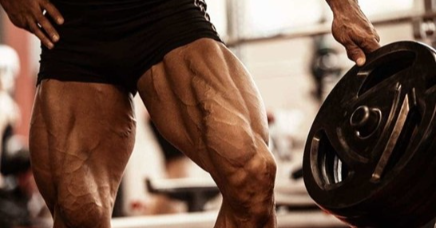7 Deadlift Tips You Haven’t Tried

1. Stand on Plates
Ever shoot for a new personal best only to feel like someone snuck in and nailed the weights to floor? Last set practically leapt off the ground. Add a few more pounds, and the plates suddenly don’t even budge. It’s baffling. What to do?
Drill your weakness until it becomes a strength.
If you have trouble pulling the weight from the floor, try doing some deficit deadlifts. Stack a 45 plate or two and stand on them, placing you 1 to 3 inches higher. Train this longer, more difficult pull with light weight until you become comfortable, then work up to 50%, 75%, and even 90% of your best deadlift before taking another run at that PR.

By elevating your starting position (standing on something), the first several inches of the pull become much more difficult – which is exactly what we want. Once you master this harder version, pulling from the floor – with its shorter range of motion and more favorable leverages -- becomes a breeze.
Plain and simple: Deficit deadlifts increase power at the bottom of your lift, which will help you get stronger at breaking the weight off the ground.
2. Roll the Bar
The principle behind this seemingly bizarre tip is simple physics: objects in motion tends to stay in motion, objects at rest tend to stay at rest (thank you, Isaac Newton). Once the bar is moving along the floor, it's easier to get it up. Sure, it sounds a bit crazy. But if you start to watch for it, you'll quickly realize virtually all the top deadlifters in the world start their pulls with a roll. Anyone care to tell this guy he's doing it wrong?

It's like rocking a car stuck in the snow; you move it back and forth to get it moving and then it goes. Essentially, get into deadlift position, roll the bar out in front of you and then roll the bar back towards you. When the bar hits your shins, pull it up and deadlift like normal.
There are some other additional benefits to rolling the bar before lifting it, including greater use of the stretch reflex, which is generally missing in the deadlift. Rolling the bar toward you also helps activate the lats for better stability, as they contract to produce the pull that starts the bar moving.
The downside of rolling the bar is that it takes a while to get used to – it might take 5-10 deadlift sessions before you really start getting comfortable with it. If you time it wrong, you'll start pulling before the bar is in close enough, putting you in a worse position than where you started from.
To practice this you have to perform stop reps, which may not work depending on your lifting style and what you're trying to work on. It doesn't work with rack pulls and the like, and the "dip, grip, and rip" style deadlifters will likely find themselves thrown off their game.
Here's a video demonstrating the roll before pulling:
3. Ignorance is Bliss
Lifting max weight is almost as much a psychological exercise as a physical one. It can be shockingly effective to be unaware exactly how much weight is on the bar.
Try having someone else load the bar for you. Instruct a buddy to put on anything from 95% to 105% of your current 1 rep max. If your current best is 405 pounds, they would load something between 385 and 425.

Don’t sit around and watch them load it. Additionally, suggest they use unusual plate combinations that make it difficult for you to recognize how much you’re about to pull – tack on 10 and 5 pound plates to reach the final total.
This also requires a bit of an honor-system: when it’s time, walk up and pull with everything you’ve got… don’t do the math.
It might surprise you how easily you can hit 415 when you think it’s 405.
4. Increase Frequency
If your goal is improving your deadlift, you may simply have to deadlift more. You're not some delicate flower, and despite it's frequent use as an excuse, even most serious lifters will never genuinely "over-train". As long as you use decent technique and don't attempt a PR every single time, it's entirely possible to safely deadlift multiple times a week.
Weightlifting is a sport and every sport involves technique. If your goal was to become a better free throw shooter, you would not be practicing your free throws one time per week; you would be shooting free throws all week.
Performing a deadlift is all about technique and form. When you increase your frequency, you are increasing your ability to deadlift. Increasing your deadlift 2-3 times per week will result in greater muscle recovery and improved technique.
5. Don’t Always Use a Mixed Grip
If you’re a raw lifter pulling very heavy weights, then sure, mix it up – one hand using an overhand grip, the other using underhand. For a heavy set of under 5 repetitions a mixed grip may be the only way to hold on to the bar.
But doing every warm up set, every 10-rep set, and all your other deadlift variations with a mixed grip simply because it’s what you’ve become accustomed to, is bad news.
Having one arm internally rotated with the other externally rotated is a way to give muscle imbalances a huge platform to take over and affect the body. While the mixed grip is a quick fix for grip issues, overuse of it eventually becomes its own anatomy class.
Perpetual mixed-grippers often find themselves learning the names of muscles like the supraspinatus and levator scapulae as they google strange, nagging upper back issues that seem to come out of nowhere... and only effect one side.
Bet them a dollar it's the same side they go underhand on for their mixed grip and you'll likely wind up 100 cents richer.
Bottom line: Use the mixed grip for your heaviest sets, but otherwise, practice a double overhand grip.
6. Keep Your Chin Up
Ask most "experts" about head and neck position during the deadlift and you'll immediately hear tips like "maintain a neutral spine," or "keep the chin tucked and neck packed." However, a lot of good lifters disagree.

In the early days lifters tended to look up or keep their chin high when deadlifting, likely because they instinctively figured out it works better. However, as the academics started to enter the strength training world and biomechanics was better understood, the goal on most exercises shifted to achieving and maintaining a neutral spine position from the lower back through to the neck and head.
This is probably a good idea on most exercises – but good form for most exercises somehow became good form for all exercises, and now we have a problem. Because if you want to pull big weights, you should not look down or straight ahead but up to the ceiling with your chin high.
Why Up?
The first reason to look up is muscular. When you extend your neck, it makes some of the muscles in your trunk, namely the posterior muscles, contract better.
According to strength training legend Mel Siff, flexing your neck (looking down) causes your back muscles to relax, while extending your neck helps them contract.
The second reason to keep the chin high is due to biomechanics and leverages. A big challenge when deadlifting heavy is being able to lock out the weight at the top. It's common for the shoulders to roll forward a bit when going heavy.
The cervical section of the vertebral column (neck) is connected to the thoracic section of the vertebral column (trunk). The more rounded (flexed) the neck is, the easier it is to round the trunk. The more extended the neck is, the harder it is to (excessively) round the upper back.
A little rounding of the thoracic region is okay, but if you've ever managed to lift a heavy bar above your knees and then got stuck because your shoulders were too far forward, you know what can go wrong.
Not everyone is built the same, and optimal head position for one person may not be optimal for another. Obviously, someone with a preexisting neck issue should use caution or just skip the idea altogether and maintain a neutral position.
The final reason to look up when deadlifting? Because it works. The list of lifters that use the "chin-high" method is lengthy, and includes names like Kirk Karwoski, Andy Bolton, and Ed Coan. You've heard the expression, "Success leaves clues"? Well, that's a big clue.
7. Elbows In
Having the lats – AKA your “wings” - braced hard during the deadlift will not only allow you to generate more force, but also help bulletproof your back. Activating the lats protects the much smaller, easily injured, upper back/shoulder blade muscles that would otherwise be forced to pick up the slack.
As you set up to pull, think about pinning your elbows against yourself – as though you had an orange pinned between your upper arm and your side and you were trying to juice that sucker. Once you find the right squeeze and feel the lat fire, it will immediately click.
The same cue also does wonders to wake up lazy lats for lifters who over-engage their biceps during pull-ups and lat pull downs.
Also in News

Upper Chest Won't Grow? It's the Bench Angle.
Your upper chest is flat because your incline bench angle is sabotaging you. One simple adjustment changes everything.

How to Build Legs When Gym's Busy AF
Gym's packed and you can't get a squat rack or a leg press? All you need is 1 heavy dumbbell and you'll never sweat a crowded gym again. Here's the play...

Lifting vs Cardio for Fat Loss: What’s REALLY Better?
Which one’s truly best for cutting body fat? Here’s what the latest science has to say. 💪🔥



